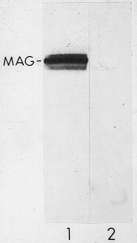Home, Search, Index, Links, Pathology, Molecules, Syndromes,
Muscle, NMJ, Nerve, Spinal, Ataxia, Antibody & Biopsy, Patient Info
|
Home, Search, Index, Links, Pathology, Molecules, Syndromes, Muscle, NMJ, Nerve, Spinal, Ataxia, Antibody & Biopsy, Patient Info |
|
Clinical Indications for measurement Interpretations of positive results Laboratory standards Patterns with specificity for demyelinating neuropathies Therapy: Guidelines |
|
 MAG staining on Western blot |
|
|
Indications Adult onset neuropathy: Distal; Symmetric; Sensory > Motor ↑ Likelihood of positive test: Age > 50 Gait disorder Tremor Disability 2° sensory or motor loss Demyelination Usually with ↑ Distal latency No conduction block Serum IgM M-protein: 85% Treatment follow-up Document sufficient cytoxan Best prognosis: Anti-MAG titers ↓ by > 60% Usually with cytoxan Rx |
+ Results ELISA IgM vs MAG > 1,500 Low IgM vs Histone H3 Western blot confirmation Clinical correlation: Titer > 6,000 Demyelinating neuropathy 90% specificity; 95% sensitivity Lab standards Document 90% clinical specificity Interpretation Diagnosis Dx of immune neuropathy Distinguish from CIDP Prognosis: Slow progression Treatment Cytoxan may be useful Prednisone & HIG not useful Follow-up ↑ Anti-MAG titer → ? Relapse |
||